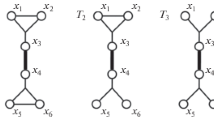Abstract
In the article the problem of finding the maximum multiple flow in the network of any natural multiplicity k is studied. There are arcs of three types: ordinary arcs, multiple arcs and multi-arcs. Each multiple and multi-arc is a union of k linked arcs, which are adjusted with each other. The network constructing rules are described. The definitions of a divisible network and some associated subjects are stated. The important property of the divisible network is that every divisible network can be partitioned into k parts, which are adjusted on the linked arcs of each multiple and multi-arc. Each part is the ordinary transportation network. The main results of the article are the following subclasses of the problem of finding the maximum multiple flow in the divisible network. 1. The divisible networks with the multi-arc constraints. Assume that only one vertex is the ending vertex for a multi-arc in s network parts. In this case the problem can be solved in a polynomial time. 2. The divisible networks with the weak multi-arc constraints. Assume that only one vertex is the ending vertex for a multi-arc in k-1 network parts (1 ≤ s < k − 1) and other parts have at least two such vertices. In that case the multiplicity of the maximum multiple flow problem can be decreased to k - s. 3. The divisible network of the parallel structure. Assume that the divisible network component, which consists of all multiple arcs, can be partitioned into subcomponents, each of them containing exactly one vertex-beginning of a multi-arc. Suppose that intersection of each pair of subcomponents is the only vertex-network source x 0. If k=2, the maximum flow problem can be solved in a polynomial time. If k ≥ 3, the problem is NP-complete. The algorithms for each polynomial subclass are suggested. Also, the multiplicity decreasing algorithm for the divisible network with weak multi-arc constraints is formulated.
Similar content being viewed by others
References
Rublev, V.S. and Smirnov, A.V., Flows in multiple networks, Yarosl. Pedagog. Vestn., 2011, vol. 3, no. 2, pp. 60–68.
Ford, L.R. and Fulkerson, D.R., Flows in Networks, Princeton University Press, 1962.
Papadimitriou, Ch.H. and Steigliz, K., Combinatorial Optimization: Algorithms and Complexity, Prentice Hall, 1982.
Roublev, V.S. and Smirnov, A.V., The problem of integer-valued balancing of a three-dimensional matrix and algorithms of its solution, Model. Anal. Inf. Syst., 2010, vol. 17, no. 2, pp. 72–98.
Smirnov, A.V., Some solvability classes for the problem of integer balancing of a three-dimensional matrix with constraints of second type, Model. Anal. Inf. Syst., 2013, vol, 20, no. 2, pp. 54–69.
Smirnov, A.V., Some solvability classes for the problem of integer balancing of a three-dimensional matrix with constraints of the second type, Autom. Control Comput. Sci., 2014, vol. 48, no. 7, pp. 543–553.
Korbut, A.A. and Finkelstein, J.J., Diskretnoe programmirovanie (Discrete Programming), Nauka, 1969.
Raskin, L.G. and Kirichenko, I.O., Mnogoindeksnye zadachi lineinogo programmirovaniya (Multi Index Problems of Integer Programming), Radio i svyaz, 1982.
Spieksma, F.C.R., Multi index assignment problems: Complexity, approximation, applications, in Nonlinear Assignment Problems. Algorithms and Applications, Pardalos, P.M. and Pitsoulis, L.S., Eds., Kluwer Academic Publishers, 2000.
Afraimovich, L.G., Three-index linear programs with nested structure, Autom. Remote Control, 2011, vol. 72, no. 8, pp. 1679–1689.
Kondakov, A.S. and Roublev, V.S., The problem of balancing of a matrix plan, Proc. Odessa Seminar on Discrete Mathematics, Odessa, 2005, no. 2, pp. 24–26.
Korshunova, N.M. and Roublev, V.S., The problem of integer balancing of a matrix, Sovremennye problemy matematiki i informatiki (Current Problems in Mathematics and Informatics), Yaroslavl, 2000, pp. 145–150.
Smirnov, A.V., The problem of integer-valued balancing of a three-dimensional matrix and network model, Model. Anal. Inf. Syst., 2009, vol. 16, no. 3, pp. 70–76.
Afraimovich, L.G. and Prilutskii, M.Kh., Multiindex resource distributions for hierarchical systems, Autom. Remote Control, 2006, vol. 67, no. 6, pp. 1007–1016.
Afraimovich, L.G. and Prilutskii, M.Kh., Multicommodity flows in tree-like networks, J. Comput. Syst. Sci. Int., 2008, vol. 47, no. 2, pp. 214–220.
Hoffman, A.J. and Kruskal, J.B., Integral boundary points of convex polyhedra, in Linear Inequalities and Related Systems, Kuhn, H.W. and Tucker, A.W., Eds., Princeton: University Press, 1972.
Roublev, V.S. and Smirnov, A.V., NP-completeness of the integer balancing problem for a three-dimensional matrix, Dokl. Math., 2010, vol. 82, no. 3, pp. 912–914.
Smirnov, A.V., Some polynomial subclasses for the problem of finding the maximum multiple flow in a divisible network, Proc. Discrete Models in Control Systems Theory: IX International Conference, 2015, pp. 229–231.
Garey, M.R. and Johnson, D.S., Computers and Intractability: A Guide to the Theory of NP-Completeness, W.H. Freeman, 1979.
Karp, R., Reducibility among combinatorial problems, in Complexity of Computer Computations, Miller, R.E. and Thatcher, J.W., Eds., Plenum, 1972.
Author information
Authors and Affiliations
Corresponding author
Additional information
Published in Russian Modelirovanie i Analiz Informatsionnykh Sistem, 2015, Vol. 22, No. 4, pp. 533–545.
The article was translated by the authors.
About this article
Cite this article
Smirnov, A.V. The problem of finding the maximum multiple flow in the divisible network and its special cases. Aut. Control Comp. Sci. 50, 527–535 (2016). https://doi.org/10.3103/S0146411616070191
Received:
Published:
Issue Date:
DOI: https://doi.org/10.3103/S0146411616070191




